
Baron Vladimir Harkonnen is a fictional character in the Dune franchise created by Frank Herbert. He is primarily featured in the 1965 novel Dune and is also a prominent character in the Prelude to Dune prequel trilogy (1999–2001) by Herbert's son Brian and Kevin J. Anderson. The character is brought back as a ghola in the Herbert/Anderson sequels which conclude the original series, Hunters of Dune (2006) and Sandworms of Dune (2007).

The Tragedy of Hamlet, Prince of Denmark, often shortened to Hamlet, is a tragedy written by William Shakespeare sometime between 1599 and 1601. It is Shakespeare's longest play. Set in Denmark, the play depicts Prince Hamlet and his attempts to exact revenge against his uncle, Claudius, who has murdered Hamlet's father in order to seize his throne and marry Hamlet's mother. Hamlet is considered among the "most powerful and influential tragedies in the English language", with a story capable of "seemingly endless retelling and adaptation by others". It is widely considered one of the greatest plays of all time. Three different early versions of the play are extant: the First Quarto ; the Second Quarto ; and the First Folio. Each version includes lines and passages missing from the others.

A protagonist is the main character of a story. The protagonist makes key decisions that affect the plot, primarily influencing the story and propelling it forward, and is often the character who faces the most significant obstacles. If a story contains a subplot, or is a narrative made up of several stories, then each subplot may have its own protagonist.

Hamlet is a 1996 British epic historical drama film and an adaptation of William Shakespeare's play Hamlet, adapted and directed by Kenneth Branagh, who also stars as Prince Hamlet. The film also features Derek Jacobi as King Claudius, Julie Christie as Queen Gertrude, Kate Winslet as Ophelia, Michael Maloney as Laertes, Richard Briers as Polonius, and Nicholas Farrell as Horatio. Other cast members include Robin Williams, Gérard Depardieu, Jack Lemmon, Billy Crystal, Rufus Sewell, Charlton Heston, Richard Attenborough, Judi Dench, John Gielgud and Ken Dodd.

Polonius is a character in William Shakespeare's play Hamlet. He is chief counsellor of the play's ultimate villain, Claudius, and the father of Laertes and Ophelia. Generally regarded as wrong in every judgment he makes over the course of the play, Polonius is described by William Hazlitt as a "sincere" father, but also "a busy-body, [who] is accordingly officious, garrulous, and impertinent". In Act II, Hamlet refers to Polonius as a "tedious old fool" and taunts him as a latter day "Jephtha".
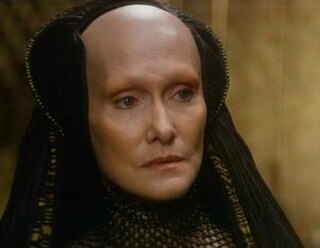
Gaius Helen Mohiam is a fictional character in the Dune universe created by Frank Herbert. She is a Bene Gesserit Reverend Mother, and initially appears in the 1963–65 novel Dune and its 1969 sequel, Dune Messiah. Mohiam also has a major role in the Prelude to Dune prequel trilogy (1999–2001) and the Caladan Trilogy (2020–2022) by Brian Herbert and Kevin J. Anderson.
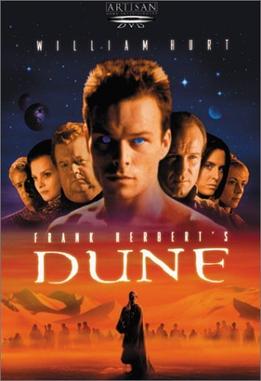
Frank Herbert's Dune is a 2000 science fiction television miniseries, based on the 1965 novel of the same title by Frank Herbert. It is written for the screen and directed by John Harrison, and stars Alec Newman as Paul Atreides, William Hurt as Duke Leto Atreides, and Saskia Reeves as Lady Jessica, along with Ian McNeice, Julie Cox, and Giancarlo Giannini. It was an international co-production between the American cable network Syfy, and companies in Germany, Canada, and Italy. This is the second overall filmed adaptation of Herbert’s novel, following the 1984 film directed by David Lynch, and preceding Denis Villeneuve’s two-part film adaptation.

An antagonist is a character in a story who is presented as the main enemy and rival of the protagonist.
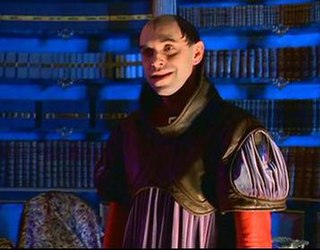
Count Hasimir Fenring is a fictional character in the Dune universe created by Frank Herbert. He is featured in the 1965 science fiction novel Dune by Frank Herbert, and is also a key character in the Prelude to Dune trilogy by Brian Herbert and Kevin J. Anderson. He later appears in the 2008 novel Paul of Dune, and the Caladan Trilogy (2020–2022).

Feyd-Rautha Harkonnen is a fictional character in the 1965 science fiction novel Dune by Frank Herbert. He is the younger nephew and heir of the Baron Vladimir Harkonnen, and is depicted to be cruel, treacherous and cunning, though not as much so as his uncle.
The title character in a narrative work is one who is named or referred to in the title of the work. In a performed work such as a play or film, the performer who plays the title character is said to have the title role of the piece. The title of the work might consist solely of the title character's name – such as Michael Collins or Othello – or be a longer phrase or sentence – such as The Autobiography of Malcolm X, Alice in Wonderland, or The Adventures of Tom Sawyer. The title character is commonly – but not necessarily – the protagonist of the story. Narrative works routinely do not have a title character, and there is some ambiguity in what qualifies as one.

King Claudius is a fictional character and the main antagonist of William Shakespeare's tragedy Hamlet. He is the brother to King Hamlet, second husband to Gertrude and uncle and later stepfather to Prince Hamlet. He obtained the throne of Denmark by murdering his brother with poison and then marrying the late king's widow. He is loosely based on the Jutish chieftain Feng who appears in Chronicon Lethrense and in Saxo Grammaticus' Gesta Danorum. There has never been an actual Danish king of that name.

Harry Potter and the Half-Blood Prince is a fantasy novel written by British author J. K. Rowling and the sixth and penultimate novel in the Harry Potter series. Set during Harry Potter's sixth year at Hogwarts, the novel explores the past of the boy wizard's nemesis, Lord Voldemort, and Harry's preparations for the final battle against Voldemort alongside his headmaster and mentor Albus Dumbledore.

Margot, Lady Fenring is a fictional character from the Dune universe created by Frank Herbert. She is featured in Herbert's Dune (1965), and is a major character in the Prelude to Dune prequel trilogy (1999–2001) and the 2008 novel Paul of Dune by Brian Herbert and Kevin J. Anderson. She later appears in the Caladan Trilogy (2020–2022). Margot is the Bene Gesserit wife of Count Hasimir Fenring, a close friend of the Padishah Emperor Shaddam IV, but is loyal to the Sisterhood.

Prince Hamlet is the title character and protagonist of William Shakespeare's tragedy Hamlet (1599–1601). He is the Prince of Denmark, nephew to the usurping Claudius, and son of King Hamlet, the previous King of Denmark. At the beginning of the play, he is conflicted whether, and how, to avenge the murder of his father, and struggles with his own sanity along the way. By the end of the tragedy, Hamlet has caused the deaths of Polonius, Laertes, Claudius, and Rosencrantz and Guildenstern, two acquaintances of his from childhood. He is also indirectly involved in the deaths of his love Ophelia (drowning) and of his mother Gertrude.
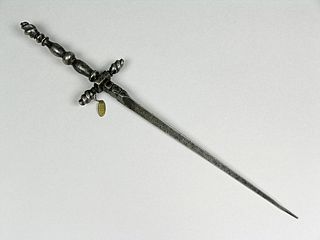
A poniard or poignard is a long, lightweight thrusting knife with a continuously tapering, acutely pointed blade, and a cross-guard, historically worn by the upper class, noblemen, or members of the knighthood. Similar in design to a parrying dagger, the poniard emerged during the Middle Ages and was used during the Renaissance in Western Europe, particularly in France, Switzerland, and Italy.
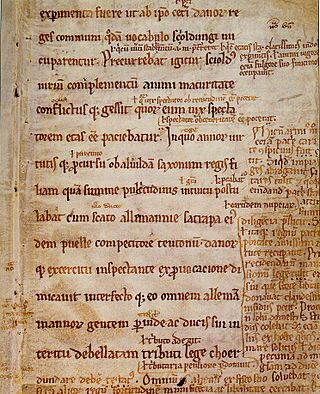
The sources of Hamlet, Prince of Denmark, a tragedy by William Shakespeare believed to have been written between 1599 and 1601, trace back as far as pre-13th century. The generic "hero-as-fool" story is so old and is expressed in the literature of so many cultures that scholars have hypothesized that it may be Indo-European in origin. A Scandinavian version of the story of Hamlet was put into writing around 1200 AD by Danish historian Saxo Grammaticus in his work Gesta Danorum. It is from this work that Shakespeare borrowed to create Hamlet. Similar accounts are found in the Icelandic Saga of Hrolf Kraki and the Roman legend of Lucius Junius Brutus, both of which feature heroes who pretend to be insane in order to get revenge. A reasonably accurate version of Saxo's story was translated into French in 1570 by François de Belleforest in his Histoires Tragiques. Belleforest embellished Saxo's text substantially, almost doubling its length, and introduced the hero's melancholy.

Ophelia is a character in William Shakespeare's drama Hamlet (1599–1601). She is a young noblewoman of Denmark, the daughter of Polonius, sister of Laertes and potential wife of Prince Hamlet, who, due to Hamlet's actions, ends up in a state of madness that ultimately leads to her drowning.

Elsinore is a 2019 point-and-click adventure game developed and published by Golden Glitch for Windows, Linux, and macOS. The game follows the character of Ophelia from William Shakespeare's Hamlet. In Elsinore, Ophelia has a vision of the deaths of everyone in Elsinore Castle and relives the same four days again and again as she works to prevent the tragedy that will fall over everyone.

Dune: Part Two is a 2024 American epic science fiction film directed and produced by Denis Villeneuve, who co-wrote the screenplay with Jon Spaihts. The sequel to Dune (2021), it is the second of a two-part adaptation of the 1965 novel Dune by Frank Herbert. It follows Paul Atreides as he unites with the Fremen people of the desert planet Arrakis to wage war against House Harkonnen. Timothée Chalamet, Zendaya, Rebecca Ferguson, Josh Brolin, Dave Bautista, Stellan Skarsgård, Charlotte Rampling, and Javier Bardem reprise their roles from the first film, with Austin Butler, Florence Pugh, Christopher Walken, Léa Seydoux, and Souheila Yacoub joining the ensemble cast.


















